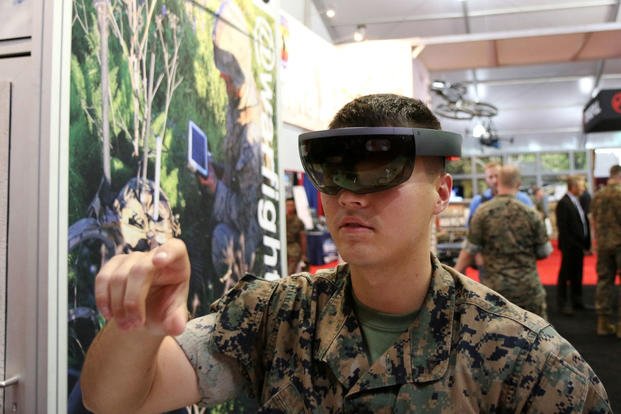The Marine Corps Warfighting Lab just finished a rapid capability assessment of a pair of Microsoft goggles equipped with augmented reality that allow artillery maintainers to work on three-dimensional models of M777 155mm howitzers.
Lance Cpl. Nicholas Reedy, an artillery maintainer, demonstrated the Enhanced Maintenance Operations technology at Modern Day Marine 2018. Wearing the augmented reality goggles, he became totally focused on a digital model of an M777 that appeared in front of him.
"I like it ... you can tell what's missing, what's broken, what's cracked," he said. "It can't do much for me right now, but when I was back at the schoolhouse, this would have helped out a lot to actually see parts in the howitzer. I am a very visual person; looking at a schematic doesn't help me much."
The Marine Corps worked with the Army Armament Research, Development and Engineering Center, or ARDEC, on the project, according to Mark Gilday, project lead for the Warfighting Lab's Rapid Capability Office.
The assessment ran from July to September and involved Marines at the Basic School, he said.
"We are now in the process of writing the report, which will go to a board of general officers with a recommendation for how to and why to continue with the technology of where we think future applicability lies," Reedy said.
The RCO purchased eight pairs of the goggles, which run on Windows 10, for about $3,000 each.
"Within training, it runs the spectrum. It can be maintainer training, it can be infantry training, it can be gun-drill training. I was talking to some snipers earlier. This could be used on a sniper training range, where you have the snipers crawling through the grass trying to get within shot range and not be observed while they are doing so," Gilday said.
"Currently, how are they being observed -- through a telescope. You can augment that telescope, which uses the human eyeball, with the laser range finding that the goggles are capable of, to pick up variances in the terrain in order to better detect those snipers, which will make them better snipers because now they've got to beat technology," he added.
Gilday said he is confident that the program will continue, since the Marine Corps and other services are focused on finding ways to use augmented reality in training.
"It seems unlikely that it's going to go away," he said. "We have Marine Corps Systems Command, [which] is interested in augmented reality ... and we have all been talking about these systems and what they are capable of."
-- Matthew Cox can be reached at matthew.cox@military.com.










